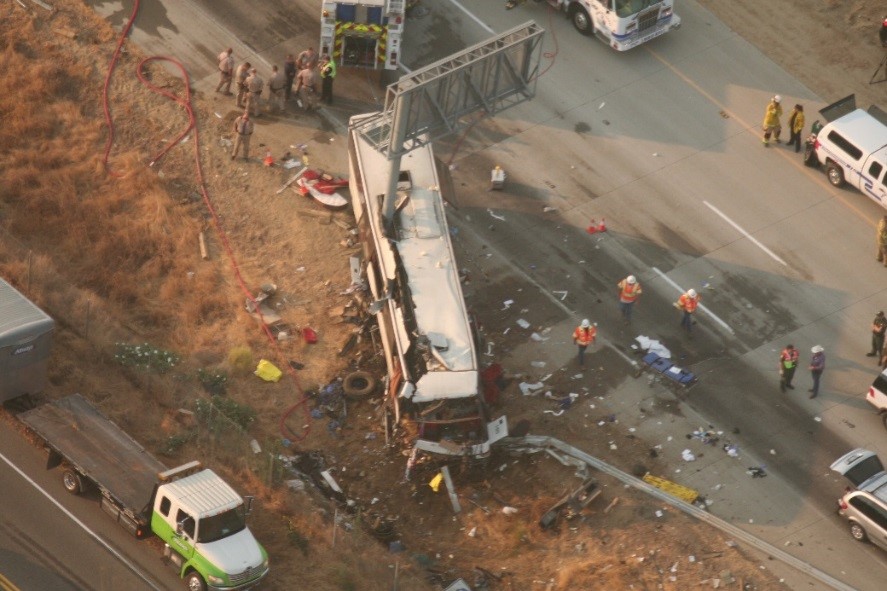NTSB Says Federal Regulator Not Doing Enough to Keep Unsafe Operators Off Roads
11/13/2017
WASHINGTON (November 13, 2017) – A sleep-deprived driver operating a motorcoach during early morning hours on a California highway caused a crash that killed four of the 24 passengers, the National Transportation Safety Board said in a report released Monday.
“Here’s yet another fatal crash involving both a motorcoach carrier with a starkly evident history of safety problems and a severely fatigued driver,” said NTSB Chairman Robert L. Sumwalt. “It’s time that the Federal Motor Carrier Safety Administration move more aggressively to keep these unsafe carriers off American roadways.”
A motorcoach operated by Fresno-based Autobuses Coordinados USA Inc., traveling from Los Angeles to Modesto on State Route 99, drifted out of its travel lanes, striking a barrier system and a highway signpost shortly after 3 a.m., Aug. 2, 2016, near Livingston, California. The crash forces resulted in the signpost entering the passenger compartment and tearing through almost the entire length of the vehicle. The surviving passengers received serious-to-minor injuries.

Aerial view of SR-99 northbound lanes, showing motorcoach at final rest and impact damage caused by 14-inch-diameter signpost penetrating two-thirds of vehicle, from front to back. (Photo: California Highway Patrol)
Investigators determined the driver, who was seriously injured, had only about five hours of opportunity for sleep in the 40 hours preceding the crash, leaving him in a state of “acute sleep loss” at the time of the crash. There were no tire marks or other indication the driver took any action to avoid the barrier after the motorcoach drifted out of its travel lane.
According to FMCSA records Autobuses Coordinados vehicles failed eight of 29 federal inspections in just under two years, pushing its out-of-service rate to 38 percent, almost five times greater than the national average of eight percent.
After determining that inadequate safety practices of Autobuses Coordinados and the FMCSA’s lack of oversight of contributed to the crash, the NTSB called on the FMCSA to change its motor carrier safety rating system to ensure carriers with serious safety issues either mitigate those risks or be placed out of service.
In its report the NTSB cited two 2011 motorcoach crashes it investigated that also occurred during early morning hours involving sleep-deprived drivers – a 15-fatality crash in New York City at 5:38 a.m., and a four-fatality crash in Doswell, Virginia, at 4:55 a.m. – and said those driving during early morning hours, when human performance is often degraded, present a unique risk to safety. To address that risk the NTSB reiterated an earlier recommendation that the FMCSA incorporate scientifically based fatigue mitigation strategies into hours-of-service regulations for passenger-carrying drivers operating overnight.
The NTSB also determined that the guardrail, which did not prevent the motorcoach from colliding with the signpost, and was not designed to do so, contributed to the severity of the crash.
The NTSB also issued two new recommendations aimed at developing risk-based guidelines to determine where high-performance barrier systems should be installed to shield heavy vehicles, such as motorcoaches, from roadside obstacles and hazards.
The entire 62-page report, including the two new and five reiterated safety recommendations, is available at https://go.usa.gov/xnDSQ.
An executive summary of the report, including the findings, probable cause, and safety recommendations, is available in Spanish at https://go.usa.gov/xnDSN.
========================
Fatigue, poor safety caused deadly Livingston bus crash
LOS ANGELES -- A severely sleep-deprived driver and a bus company with a poor safety record were causes of an August 2016 crash in California's Central Valley that killed four passengers and injured 20 others, including the driver, federal safety investigators said Monday.
The National Transportation Safety Board said the driver had only slept about five hours over the 40 hours preceding the Aug. 2, 2016 crash. The bus traveling from Los Angeles to Modesto drifted off the right side of Route 99 and struck a highway signpost that nearly sliced the bus from nose to tail. There were no signs the driver tried to stop or steer back on the highway.
The NTSB said a contributing cause was inadequate oversight by the federal agency regulating bus safety that allowed Fresno-based Autobuses Coordinados USA Inc. to continue operating despite a poor safety record. It called on the Federal Motor Carrier Safety Administration to change its rating system to make sure companies either fix serious safety issues or be taken off the road.
"Here's yet another fatal crash involving both a motor coach carrier with a starkly evident history of safety problems and a severely fatigued driver," said NTSB Chairman Robert L. Sumwalt. "It's time that the Federal Motor Carrier Safety Administration move more aggressively to keep these unsafe carriers off American roadways."
The company had failed eight of 29 federal inspections in less than two years and its out-of-service rate was nearly five times greater than the national average, yet it received a satisfactory rating from the FMCSA, the NTSB said.
Less than three months after the crash, the administration shut down the carrier after giving it an unsatisfactory safety rating, FMCSA spokesman Duane DeBruyne said Monday.
The incident was one of several fatal bus crashes in early morning hours involving fatigued drivers, including 2011 crashes that killed 15 in New York City and one that killed four in Doswell, Virginia, the NTSB said.
Fatigue was blamed in a crash that killed 13 people on Interstate 10 near Palm Springs on Oct. 23, 2016 when a charter bus traveling from a casino plowed into the rear of a big-rig whose driver had fallen asleep during a freeway closure. The truck driver was recently charged with 13 counts of vehicular manslaughter with gross negligence.
The NTSB said the August 2016 crash outside of Livingston would not have been as bad if a stronger guardrail prevented the bus from striking the signpost.
The board recommended guidelines to determine where stronger barriers should be installed to protect heavy vehicles, such as buses, from obstacles and hazards.


